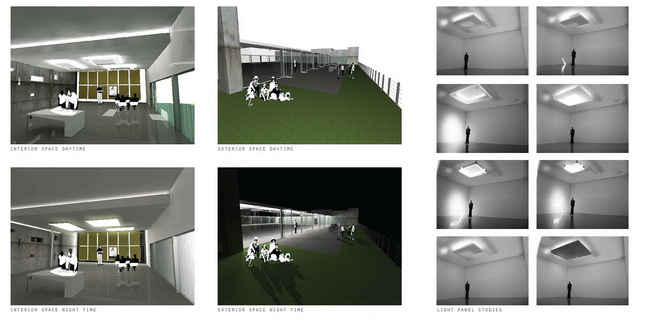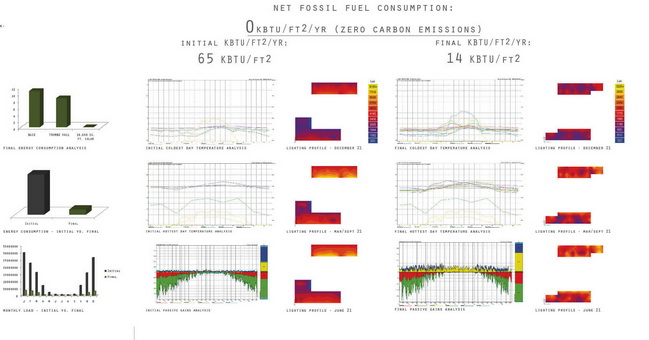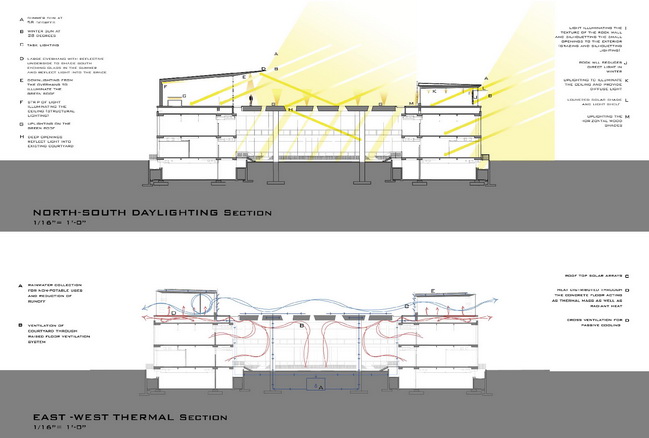Spring 2008 6.5 week TECHNOLOGY MODULE- Luminous and Thermal Design: An Ecological Approach to Zero-Energy Carbon Neutral Design
Whole Building Integration

Design Performance Objective |
Whole Building Integration
Interior and exterior studies illustrating the quality and character of the luminous and thermal environments on a diurnal and seasonal basis.
|
Students: Gordon, Hara, and Zielinski
|
Software/Tools: |
|
|
Spring 2008 6.5 week TECHNOLOGY MODULE- Luminous and Thermal Design: An Ecological Approach to Zero-Energy Carbon Neutral Design
Whole Building Integration
• Integrate passive thermal and luminous design considerations as well as the key building systems including daylighting and electric lighting, heating, cooling, ventilation, and renewable energy systems.
• Meet the daylighting, thermal, ventilation, energy, greenhouse gas emissions, and other relevant design and ecological goals set by your team.
• To analyze the final design and compare the results to the original Baseline Case showing the estimated improvements in energy use, greenhouse gas (carbon dioxide) emissions, thermal comfort, daylighting performance, life-cycle cost and other metrics (performance measurement) of student’s choice.
• To make the necessary modifications to the building model, using ECOTECT, to determine the resulting changes in luminous and thermal design for zero-energy and carbon-neutral performance.
|
Investigative Strategy |
In the Project Six, teams presented a “final” iteration or evolution and evaluation of their project. They proposed an integrated design solution for the mnZED Lab Addition to Rapson Hall and compared the performance to a Baseline Case, which was their initial concept presented in Project One and analyzed as the Baseline Case in Project Two. Their “final” design proposal was informed by the analysis of incremental qualitative and quantitative design improvements made during previous projects. Students presented their findings through physical models, Ecotect studies, charts, graphs, annotated plans, sections or axonometric diagrams. They were asked to graphically illustrate how the various design strategies and related systems are integrated into a meaningful architectural and ecological whole and to consider their final energy consumption or production and greenhouse gas emissions.
|
Evaluation Process |
• Envelope study models and annotated wall sections- minimum 3
• Daylighting studies of one important room (qualitative time sequence photographs and Ecotect quantitative analysis on diurnal and seasonal basis)
• Ecotect Studies for the thermal performance for passive solar and system integration
• Physical models and graphical systems integration studies
• Written findings and conclusions on systems integration
|
|
Information about the Project and Studio |
• course outline
• project outline |
Evaluative Criteria |
• Clarity and execution of design intention demonstrated in the physical and Ecotect models
• Clarity and accuracy of parametric studies
• Clarity of intentions demonstrated in summaries, drawings, diagrams, and photographs
|
Cautions/Possible Confusions |
Emphasis should be placed on the importance of synthesizing design daylighting and thermal strategies (section, details, materials) into a comprehensive whole. Emphasis should be placed on both the qualitative and quantitative dimensions of the design to create a meaningful design proposal. |
Range of Applicability in terms of CLIMATE |
ALL |
Range of Applicability in terms of TYPE |
ALL |
Reference Material |
|
Duration of Exercise |
One and a half weeks. |
Degree of Difficulty / Previous Knowledge Required |
Introductory graduate level. |
| |


Whole Building Integration
Students: Gordon, Hara, and Zielinski (top)
Ruppert, Schwager, and Stream (bottom)
Ecotect analyses of thermal and dayligthing performance. Interior sections illustrating daylighting, thermal, and systems integration. |
|
|
|

